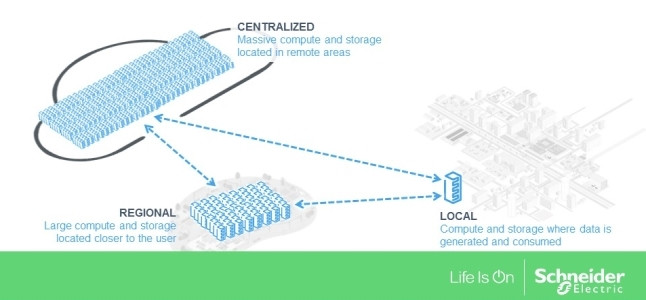
Nobody wants to see technology slow down. It's a sign of legacy, strained resources or poor design: an application or service is not performing as it should, causing a cascade of delays on the user's end.
On networks, the tell-tale sign of such a slowdown is latency. Due to how IP (Internet Protocol) architecture works, fewer hops are favoured over faster connections. This can create a lot of congestion, leading to latency.
Traditionally that wasn't such a big problem, for two reasons: many applications and services did not rely heavily on a centralised network, and high-bandwidth applications were niche. Both have changed with the advent of cloud systems.
"Cloud is incredibly powerful, but it comes at a cost," says George Senzere, Solutions Engineering Manager at Schneider Electric. "Networks are doing far more heavy lifting than before and companies are seeing their bandwidth demand grow by 50%, 100%, and even higher leaps. A lot of that pressure is currently from applications, but new demand is coming fast for IOT or M2M implementations."
In fact, it's not just cloud architecture approaching this barrier. Caching services on the Internet exist exactly to circumvent this problem by making content available closer to the end user. 5G, the next generation of mobile broadband, is highly anticipated not so much for its speeds, but its ridiculously low latency. The world needs faster networks.
But you can't simply keep adding more capacity, as that will turn the network into a money hole. Smart network design is key to keeping up with the demands of modern applications and systems. The answer to this is edge computing.
The principle of edge computing is evident in Internet caching: fundamentally it's about bringing certain functions closer to the use cases at the ends of the network. IOT devices give the clearest example of this:
Visualise a sensor that monitors temperatures in an industrial fridge. If used traditionally, this sensor will send every bit of data captured to the centre of the network, where cloud services crunch the numbers. But if you place an edge device close to the sensor, it can determine what is useful data and send only that to the centre. So, if the temperature remains normal, the sensor still reports this, but the edge device does nothing. Yet if the numbers fluctuate, the edge device pipes up and informs the mothership.
This sounds trivial, but consider if there are dozens or hundreds of sensors. Their collective traffic can really take the cream off a network's bandwidth headroom. Other examples make the need for edge computing even more poignant: video-on-demand streaming, peer-to-peer traffic, gaming, visual processing and backups are some of the fast-growing services that demand low latency and can really squeeze a network.
"Edge computing sounds like a throwback, but it is actually a big step forward. Data can be handled much more intelligently by dedicated systems, taking a lot of the noise away from the network. There are three ways we're seeing edge merge with the market: collecting information through aggregation and control points, local storage of bandwidth intensive content and on-premises replication of cloud services."
Senzere says this is a significant evolution: "Networks are vital to current and future technologies, but they are not necessarily equipped to handle those. Simply throwing more capacity at this is not a solution. Edge computing is the answer. It is much more efficient and actually a better investment. It is a lot more OPEX driven, whereas expanding networks is always going to require hefty upfront spend."
Use cases emerge every day and eventually all good ecosystems will incorporate edge computing into their thinking. Even modern security systems look increasingly to edge devices, which can help detect invaders and even isolate security assaults such as DDOS attacks. The future of delivering reliable services to companies, users and customers lies in adopting edge computing. This can be implemented at various levels, from completely local services to regional systems that improve the performance of wide area networks.
Nobody does it all by themselves. Even kings rise and fall on the words of their advisors. Edge devices are the eyes and ears in the far-flung corners of the cloud's empires. They help keep the roads clear and the king informed.
To learn more, get your free copy of the whitepaper The Drivers and Benefits of Edge Computing.
Share